Texture gradient has a profound influence on our perception of the world around us. It is one of the key visual cues that our brain uses to create a mental model of our environment. It plays a critical role in our ability to navigate and interact with that environment.
One of the ways that texture gradient influences our perception is by creating the illusion of depth and perspective. Using a gradient of visual elements that get smaller and closer together as they recede into the distance, the texture gradient creates the impression that objects are arranged in three-dimensional space.
Texture gradient also influences our perception of size and distance. By manipulating the size and spacing of visual elements, texture gradients can create the illusion that objects are larger or smaller than they actually are or that they are closer or farther away.
What is Texture Gradient, and How Does it Work?
It works by exploiting how our visual system processes information about the size, shape, and orientation of visual elements. When we look at a scene, our brain uses a combination of visual cues, such as linear perspective, overlap, and shading, to create a mental model of the environment.
It is one of these cues, and it works by creating a gradient of visual elements that get smaller and closer together as they recede into the distance. This creates an illusion of depth and perspective essential to our ability to navigate and interact with the world around us.

Texture Gradient and Depth Perception
It is closely related to depth perception, which is the ability to perceive the spatial relationships between objects in the environment. Depth perception is critical to our ability to navigate and interact with the world around us, and it is influenced by various visual cues.
Texture gradient creates the illusion of depth and perspective by using a gradient of visual elements that get smaller and closer together as they recede into the distance. This creates the impression that objects are arranged in three-dimensional space, allowing us to perceive their spatial relationships.
Gradient Texture and Visual Illusions
Gradient texture is often used in visual illusions, images that create the impression of something that is not actually there. Visual illusions are created by manipulating visual cues, such as texture gradient, color, and contrast, to create an image that tricks the brain into perceiving something that is not actually present.
It is a common visual cue used in many visual illusions, including the famous Ames room illusion. This illusion uses a distorted room with a false floor and ceiling to create the illusion of people growing or shrinking as they move around it.
Texture Gradient and Virtual Reality
Virtual reality, which immerses viewers in a computer-generated world, uses texture gradient as a visual signal. Virtual reality relies heavily on visual cues such as texture gradients to create a sense of immersion and presence in the virtual world.
By using texture gradients and other visual cues, virtual reality developers can create more realistic and engaging environments. This allows users to feel like they are actually present in the virtual environment rather than just looking at a screen.
Texture gradient psychology is a fascinating field that explores how texture, relative size, and other visual cues affect our perception of spatial depth and object orientation. By understanding how the brain processes visual information, we can gain valuable insights into how we see the world around us.
Related Article: What Is Depth Psychology
